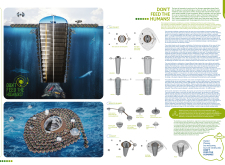5 key facts about this project
The primary function of the pavilion is to serve as an interactive space that educates visitors about marine life and ecological balance. By integrating observation areas and educational facilities, the project encourages a deeper understanding of the need to coexist with, rather than exploit, ocean resources. The layout features modular service islands that provide essential resources such as energy and waste management systems, enhancing the functionality of the pavilion.
Unique Design Approaches
One of the project’s distinct elements is its dual-level design which includes sections both above and below the waterline. This approach not only allows for immersive experiences of marine ecosystems but also integrates various uses within the same structure. The architecture emphasizes harmony between built and natural environments, creating a dialogue about the importance of marine conservation.
The design incorporates a variety of materials, specifically selected for both performance and environmental compatibility. Reinforced concrete offers structural integrity, while materials like marine-grade aluminum and fiberglass are utilized for their durability and lightweight characteristics in aquatic settings. Additionally, sustainable timber may be incorporated into the design, further emphasizing the project's commitment to environmental responsibility.
Interactive Components
Interactive elements within the pavilion play a critical role in achieving its educational aims. Elevated observation decks and submerged viewing areas invite visitors to engage with marine life without disturbing their habitats. The pavilion is powered by renewable energy sources, such as solar panels, which are integrated into the design for self-sufficiency. This attention to energy efficiency reflects a broader commitment to sustainability, showcasing architectural designs that prioritize renewable resources.
The project stands apart from conventional architectural endeavors by explicitly addressing the need for reduced human impact on natural ecosystems. The design not only serves as an architectural space but also as a venue for critical discourse regarding ecological stewardship.
For a comprehensive understanding of the pavilion’s architectural plans, sections, and design strategies, please explore the project presentation. Examining these elements will provide deeper insights into the innovative architectural ideas that define this project.























